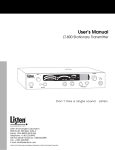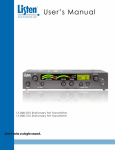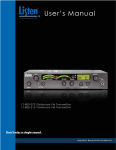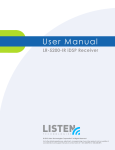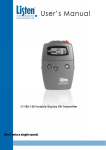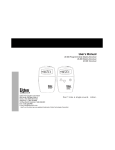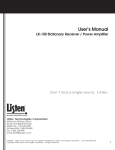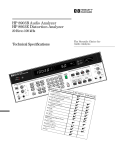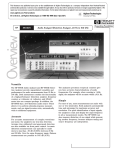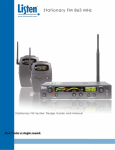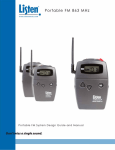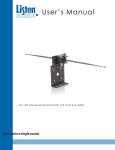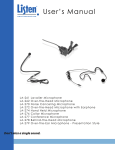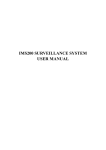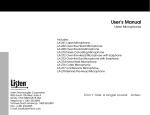Download User`s Manual - Performance Audio
Transcript
User’s Manual LR-100 Stationary Receiver / Power Amplifier Don’t miss a single sound. Listen. Listen Technologies Corporation 8535 South 700 West, Suite A Sandy, Utah 84070-2515 USA Telephone: +1.801.233.8992 Toll Free (North America): 1.800.330.0891 Fax: +1.801.233.8995 E-mail: [email protected] Welcome to Listen! Dear Valued Customer, Thank you for choosing Listen! All of us at Listen are dedicated to providing you the hightest quality products and prompt, efficient customer care. Our products are manufactured in an ISO-9000 factory that has been independently certified to the highest quality standards. We stand ready to answer any questions you might have during installation or in the operation of our products. Should there be any problems with your Listen products, we are ready to help you in any way we can. Should you have any comments on how we might improve our products or our service, we’re here to listen. Here’s how to reach us: Telephone: +1.801.233.8992 Fax: 1.801.233.8995 Toll Free (North America): 1.800.330.0891 E-Mail: [email protected] Web: www.ListenTech.com Thank you... and enjoy your listening experience! Best regards, The Listen Team LR-100 Package Contents Listen Part Number · · · · · · · · LR-100-072 for 72 MHz LR-100-216 for 216 MHz LR-100-072 (72MHz) or LR-100-216 (216MHz) or 120 VAC Power Supply LA-123 90 Degree Helical Antenna (72MHz) or LA-124 90 Degree Helical Antenna (216MHz) Allan Wrench Warranty Card User Manual Optional Accessories See page 20 i Listen™ and the Listen Logo are registered trademarks of Listen Technologies Corporation. LR-100_2004_08_03 © 2003 Listen Technologies Corporation. All Rights Reserved. Architectural Specifications . . . . . . . . . . . . . . . . . . . . . . . . . . . . . . . . . . . . . . . . . . .2 Specifications . . . . . . . . . . . . . . . . . . . . . . . . . . . . . . . . . . . . . . . . . . . . . . . . . . . . . . .2 Quick Reference . . . . . . . . . . . . . . . . . . . . . . . . . . . . . . . . . . . . . . . . . . . . . . . . . . . .3 Block Diagram . . . . . . . . . . . . . . . . . . . . . . . . . . . . . . . . . . . . . . . . . . . . . . . . . . . . . .5 Setup . . . . . . . . . . . . . . . . . . . . . . . . . . . . . . . . . . . . . . . . . . . . . . . . . . . . . . . . . . . . .6 Installation . . . . . . . . . . . . . . . . . . . . . . . . . . . . . . . . . . . . . . . . . . . . . . . . . . . . . . . . .7 Speaker Connection . . . . . . . . . . . . . . . . . . . . . . . . . . . . . . . . . . . . . . . . . . . . . . . . .8 Antenna Installation . . . . . . . . . . . . . . . . . . . . . . . . . . . . . . . . . . . . . . . . . . . . . . . . .8 Programming . . . . . . . . . . . . . . . . . . . . . . . . . . . . . . . . . . . . . . . . . . . . . . . . . . . . . . .9 Squelch Adjustment . . . . . . . . . . . . . . . . . . . . . . . . . . . . . . . . . . . . . . . . . . . . . . . .10 Troubleshooting . . . . . . . . . . . . . . . . . . . . . . . . . . . . . . . . . . . . . . . . . . . . . . . . . . . .11 Listen SQ™ . . . . . . . . . . . . . . . . . . . . . . . . . . . . . . . . . . . . . . . . . . . . . . . . . . . . . . .12 Channel Selection . . . . . . . . . . . . . . . . . . . . . . . . . . . . . . . . . . . . . . . . . . . . . . . . . .13 RF Reception Maximization Strategies . . . . . . . . . . . . . . . . . . . . . . . . . . . . . . . . .14 Resetting After an Overload Condition . . . . . . . . . . . . . . . . . . . . . . . . . . . . . . . . .14 Coaxial Cable . . . . . . . . . . . . . . . . . . . . . . . . . . . . . . . . . . . . . . . . . . . . . . . . . . . . .15 72 MHz Frequency Compatibility Table . . . . . . . . . . . . . . . . . . . . . . . . . . . . . . . . .16 216 MHz Frequency Compatibility Table . . . . . . . . . . . . . . . . . . . . . . . . . . . . . . . .17 Compliance Notice . . . . . . . . . . . . . . . . . . . . . . . . . . . . . . . . . . . . . . . . . . . . . . . . .18 FCC Statement . . . . . . . . . . . . . . . . . . . . . . . . . . . . . . . . . . . . . . . . . . . . . . . . . . . .18 Warranty . . . . . . . . . . . . . . . . . . . . . . . . . . . . . . . . . . . . . . . . . . . . . . . . . . . . . . . . .19 Optional Accessories . . . . . . . . . . . . . . . . . . . . . . . . . . . . . . . . . . . . . . . . . . . . . . . .20 Table of Contents Table of Contents Specifications Specifications Architectural Specifications The FM stationary receiver - power amplifier (receiver) shall be capable of receiving on 57 wide and narrow band channels in the frequency ranges of either 72MHz or 216MHz. The receiver shall be programmable to electronically lock out unneeded channels. The device shall have an adjustable squelch with an LED indication. The frequency response of the device shall be within 3dB from 63Hz to 15KHz at 72MHz, or within 3dB from 63Hz to 10kHz at 216MHz. The signal to noise ratio shall be 80dB or greater. The device will have an integrated power amplifier capable of driving an 8 Ohm speaker. The device shall be rack mountable and shall have the capability of a remote antenna. The device shall incorporate an LCD display that indicates channel and RF signal strength. The Listen LR-100 is specified. Specifications Specification LR-100-072 RF Frequency Range Number of Channels Sensitivity Frequency Accuracy RF Antenna Optional Antennas Antenna Connector Squelch Compliance System Frequency Response System Signal-to-Noise Ratio (A-weighted) System Distortion Auxiliary Input to Output Balanced Auxiliary Input Audio Unbalanced Auxiliary Input Balanced Output Unbalanced Output Headphone Output Speaker Output ** All system specifications are wireless end-to-end 63Hz - 15kHz (±3dB) 63Hz - 10kHz (±3dB) SQ enabled: 80dB; SQ disabled SQ enabled: 80dB; SQ disabled 60dB 50dB <2% total harmonic distortion (THD) at 80% deviation Frequency Response: 25Hz to 20kHz (±3dB), SNR: >80dB, Distortion: <0.2% Rear panel. One Female XLR-1/4 in combo connector, balanced, 0dBu nominal input level adjustable, +13dBu maximum, impedance 600 Ohms Rear panel. Two Phono connectors, unbalanced, -10dBu nominal input level adjustable, +7dBu maximum, impedance 10k Ohms Rear panel. One Male XLR, balanced, 0dBu nominal output level, +16dBu maximum, impedance 2k/10 Ohms (line/mic) Rear panel. Two Phono connectors, unbalanced, -10dBu nominal output level, +2dBu maximum, impedance 2k Ohms Front panel. One 3.5mm stereo connector, unbalanced, adjustable output level, +16dBu maximum, impedance 32 Ohms, 120mW. Rear panel, One detachable terminal block, bridged, adjustable output level, 15/10 watts (peak/RMS) continuous power with 4 Ohm load Set-up Controls, Front Panel behind Security Cover Set-up Controls, Back Panel Controls User Controls Remote Controls Programming Indicators Power Physical VU Meter Power LCD Display Squelch Mute Power Supply Type Power Supply Input Power Supply Output Power Supply Connector Compliance Optional Battery Optional Battery Charging Dimensions Unit Weight Unit Weight w/LA-201 Power Supply Shipping Weight Rack Mounting Temperature - Operation Environmental Temperature - Storage 2 Humidity LR-100-216 72.025 - 75.975 MHz 216.025 - 216.987 MHz 57 (17 wide, 40 narrow) 57 (19 wide, 38 narrow) .6uV typical, 1 uV maximum for 12dB SINAD ± .005% stability 0° to 50°C (32° to 122° F) Flexible helical, Flexible helical, 9.0 in (23 cm) included 5.5 in (14 cm) included Several available. See www.ListenTech.com for details BNC Continuously adjustable via front panel trim pot FCC Part 15, Industry Canada Receive level, auxiliary input level, SQ on/off, squelch Audio output select (RX Only, RX + AUX, RX or AUX), Speaker (Output, Aux), switchable balanced output level Volume, channel UP/DOWN, SEEK (all controls except volume are lockable) Eight position detachable terminal block, channel up, channel down, mute Unit can be programmed so that only desired channels are displayed to the user, chaannel selection can be locked by holding the SEEK button 5 seconds. Four LED (three green, one red) Green LED illuminates when the unit is powered up Channel, RF signal strength, lock status, programming Green LED illuminates when the unit is squelched Green LED illuminates when the output audio is muted In-line power supply, Listen part number LA-201 120VAC, 60 Hz, 19 watts (maximum continuous) 15VAC, 1A .02 in OD x .01 in ID (5.0mm x 2.5mm) ID, barrel type UL Listed 12VDC, connected via terminal block Trickle charge of optional 12VDC battery through terminal block 8.0 in x 8.0 in x 1.75 in WxDxH (20.3cm x 20.3cm x 4.45cm) 2.8 lbs (1.3kg) 4.2 lbs (1.9kg) 5.6 lbs (2.5kg) 1/2 rack unit (RU), optional rack mount not include, order Listen part number LA-326 -10° to +40°C (14° to 104° F) -20° to +50° (-4° to 122° F) 0-95% relative humidity, non-condensing Quick Refernce Quick Reference LR-100 Front Panel VU METER: Set Receive and Auxiliary levels so that the red LED (at right) does not illuminate POWER switch: if operated on battery, switch is inoperative MUTE: when lit, the OUTPUT audio is muted. MUTE is activated and deactivated by a momentary closure to ground on the rear detachable terminal block (see next page). ACCESS PANEL Remove to make set-up adjustments SQUELCH: when adjusted properly, this LED is lit when the transmit audio is not being received. UP and DOWN channel tuning buttons LR-100 Behind Front Access Panel RECEIVE audio level adjustment SQUELCH adjustment: adjust so that when your transmit audio is off, the Squelch LED is illuminated. When squelched, audio is muted (this keeps you from hearing hiss in your speakers) AUXILIARY audio level adjustment SQ: to activate, move switch to ON position. This switch should be turned OFF if any of your equipment does not have SQ capability. See “Listen SQ” on Page 14 for more information. SEEK: press to find the next strong signal. Also used to lock and unlock channel selection; press and hold for 5 seconds. A padlock will appear on the display when locked. Press and hold again to unlock. HEADPHONE: Look & Listen™ Display - see details Connect a mono or stereo headphone below here - 3.5 mm plug (mini). SPEAKER control: adjusts the volume of your loudspeaker connected to the LR-100, and/or the headphone. LR-100 LCD Panel Details RF Signal Strength Indicates the currently tuned channel PGM: when showing, the unit is in Program mode to lock out unwanted channels from user access. When the padlock is visible, the channel is locked. Press and hold SEEK for 5 seconds to unlock or lock. I/O: while in Program mode, this symbol indicates that a channel is locked out and will not be available to the user. Press SEEK to toggle channels between Locked Out and non-Locked Out modes. 3 Quick Reference Quick Reference LR-100 Rear Panel Optional 12V power: connect optional battery or +12VDC source here. The battery can be recharged; see page 5. ANTENNA connection: attach supplied 90 degree helical antenna or optional remote antenna here. Uses standard 50 Ohm BNC connector. SPEAKER connection: connect a 4 Ohm (or greater) loudspeaker here. CONTROL: remote control of UP, DOWN and MUTE functions. All functions are momentary closures to common. Balanced OUTPUT: Male XLR, 0 or -40dBu nominal Unbalanced output: phono, -10dBu nominal Unbalanced AUXILIARY input: phono, -10dBu nominal Two internal 2 amp, fast blow fuses Connect provided power supply here. SPEAKER selection switch: this selects the audio being routed to the speaker amplifier to either the OUTPUT or AUXILIARY audio. MIC/LINE level switch: reduces the balanced OUTPUT audio gain by 40dB in Mic mode AUDIO OUTPUT selection: For RECEIVE audio only, select RX ONLY; For RECEIVE audio mixed with AUXILIARY audio, select RX + AUX; For RECEIVE audio when not squelched and AUXILIARY audio when squelched, select RX or AUX 4 Balanced AUXILIARY input: Combination Female XLR - ¼ in connector; 0dBu nominal Block Diagram LR-100 Block Diagram +12 VDC External Battery 3 4 Remote Control 5 6 7 Common Ground 115VAC External Power Supply LA-201 Speaker 1 2 8 Power On/Off Electronic Switch Up Mute Down Power Supply CPU Module Seek Aux Listen LCD Display Remote Antenna (Flexible helixal antenna provided) BNC Speaker Output 3.5MM Stereo SQ On/Off (internal) Headphone Mic Output Balanced 0 dBu Male XLR Audio Processing Module RF Receiver Board Detachable Terminal Block RX Line RX + Aux Receive Level RX or Aux Squelch Phono Output Select Squelch Sensitivity Electronic Switch Auxiliary Level Output Unbalanced -10 dBu VU Meter XLR-1/4" Combo Auxiliary Input Balanced 0 dBu Phono Auxiliary Input Unbalanced -10 dBu 5 Setup LR-100 Setup Instructions LR-100 Setup Instructions · If you are using the LR-100’s power amplifier, make sure the unit is given sufficient room around the ventilation holes. · If you are rack mounting the LR-100, use the optional LA-326 rack mounting kit. This kit allows for single and dual rack mounting, and comes with a security cover. · For mounting on vertical or horizontal surfaces, use the optional L bracket mounting kit, part number LA-327. Detachable Terminal Block Wiring: Powering the Unit Please note: if the unit will not power up, see Resetting After an Overload Condition, page 14. Pin 1: Pin 2: Pin 3: AC Power Operation The unit comes with a UL listed inline power supply designed for 115VAC, 60Hz operation. Do not use any other AC power supply. Use of any non-Listen supplied power supply will void the warranty. (Battery use is permitted; see below.) Plug the power supply into the back of the unit at the connector labeled POWER. Now connect the power supply to power. Pin 4: Pin 5: Pin 6: Pin 7: Pin 8: Battery Operation To operate the unit on a battery or +12VDC power supply, connect to the rear detachable terminal block as follows: i. ii. Pin 3: +12VDC Pin 4: Ground Please note that when operating on the +12VDC battery supply, the POWER switch is bypassed and the unit is always on. You can optionally charge batteries by also supplying power to unit with the batteries connected. In this case, the batteries are trickle charged at a rate of 18 36 mA. You should only use rechargeable type batteries. CAUTION: Attempting to charge non-rechargeable batteries may result in explosion and/or fire. 6 Speaker + Speaker – Ground for Battery or Power Source connection +12VDC Battery or Power Source UP remote control function DOWN remote control function MUTE remote control function Common for remote control function Transmission LR-100 Installation Installation - Audio Connections (See Quick Reference on pages 3-4.) OUTPUT Audio The OUTPUT audio section is composed of an OUTPUT audio selection switch, a male XLR balanced audio OUTPUT connector and two phono unbalanced audio OUTPUT connectors. OUTPUT Audio Selection Switch This switch selects what audio is routed to the OUTPUT audio connectors. The switch has three positions: 1. RX ONLY. In this position, only RECEIVE audio is routed to the OUTPUT. When the transmitter is turned off, the unit is squelched and the RECEIVE audio is muted. 2. RX + AUX. In this position, both the RECEIVE and AUXILIARY audio are mixed and routed to the OUTPUT. 3. RX or AUX. In this position, the OUTPUT audio is either RECEIVE or AUXILIARY audio. When the RECEIVE audio is squelched (indicated by the illumination of the SQUELCH LED on the front panel), AUXILIARY audio is routed to the OUTPUT. When RECEIVE audio is not squelched, RECEIVE audio is routed to the OUTPUT. Balanced Audio Output When connecting to the XLR balanced OUTPUT, use the pin out shown below. If the output is unbalanced, either use the unbalanced phono connectors or wire the balanced XLR output as shown below with pins 3 and 1 wired together. The OUTPUT audio has a nominal output level of 0dBu. LINE/MIC Switch This switch reduces the OUTPUT level of the balanced OUTPUT audio only. It does not affect the OUTPUT level of the unbalanced audio. The OUTPUT audio is reduced by 40dB to microphone level when this switch is selected to MIC. Unbalanced Audio Output There are two unbalanced phono audio OUTPUT connectors. The nominal OUTPUT audio level is –10dBu. AUXILIARY Input The LR-100 has an AUXILIARY input that allows for greater functionality of the unit for a variety of applications. The AUXILIARY input consists of a balanced input, combination connector (female XLR and ¼ in) and two unbalanced phono connectors. All of these inputs are actively mixed together. Thus, any combination of input sources can be used. Input level is adjusted via the front panel trim pot labeled AUX LEVEL ADJUST. Adjust this level to fit the needs of your installation ensuring the last red LED on the VU meter is not illuminated (indicating peak audio). AUXILIARY Balanced Audio Input: The nominal input level for the balanced input is 0dBu. Female XLR / ¼ in combination connector pin outs: Pin 2 (tip) + Pin 3 (ring) – Pin 1 (sleeve) Shield XLR pin out diagram for a balanced connection: Pin 2 + Pin 3 – Pin 1 Shield XLR pin out diagram for a unbalanced connection: Pin 2 + Pin 1 and 3 – AUXILIARY Unbalanced Audio Input: The nominal input level for the two unbalanced inputs is -10dBu. Female XLR / ¼ in combination connector pin outs: Pin 2 (tip) + Pin 1 and 3 ring/sleeve 7 Speaker/Antenna Install LT-100 Speaker Connection LR-100 Antenna Installation The LR-100 contains a 44-watt (31 watt RMS), 4 Ohm power amplifier. Installation – Antenna A properly installed antenna is critical to the operation of the LR-100. Without a strong and consistent RF signal from the transmitter, the LR-100 will not meet the needs of your installation. You can use the RF POWER indication on the LCD to provide a relative RF signal strength. You should see four or more dots displayed on the LCD for best results. The Speaker Selection switch determines what audio is directed to the power amplifier. With the switch in the OUTPUT position, the OUTPUT audio (same audio that is on the OUTPUT audio connectors) is directed to the power amplifier. With the switch in the AUX position, only AUXILIARY input audio is directed to the power amp. This allows you to use the power amp separate of the RECEIVER audio if desired. NOTE: When the speaker switch is in the OUTPUT position and the MUTE control is enabled (indicated by the illumination of MUTE LED), the speaker output is also muted. Connection to the speaker is achieved through pins 1 and 2 on the detachable terminal block. Strip the speaker wires, rotate the screws on the terminal block counter-clockwise, insert the wires and then tighten the screw clockwise until the wire is secure in the connector block. You may connect any parallel, series combination of speakers that produces an impedance of 4 Ohms or greater. EXAMPLE: If you have two 8 Ohm speakers, you can connect these in parallel to produce a 4 Ohm load to the power amp. The SPEAKER level control on the front panel adjusts the level of the speaker. The front panel headphone jack is in parallel with the speaker level. Connect any mono or stereo headphone to this 3.5mm jack. Adjust level with the SPEAKER volume knob. 8 Using the supplied helical antenna Connect the antenna to the rear BNC connector and orient the antenna vertically. If reception is from the transmitter is not adequate, consider using a remote antenna (see below) or place the LR-100 at an improved location to improve the signal strength. See RF Reception Maximization Strategies on page 15 for more information. Using a remote antenna For better reception in longer broadcast range applications, you should use a remote antenna. A remote antenna will allow you to get the antenna higher in altitude and in a position that is clear of obstructions. Please refer to the specific antennas instructions for installation. Also refer to “Strategies for Maximizing RF Reception” on page 15 for additional information. CAUTION: When installing antennas, ensure the antenna is clear of power lines. NOTES: If the RF signal to the 216MHz model is too high, the audio will be distorted. This may happen if the LR-100 is within 40 feet of the LT-800-216 transmitter. Consider reducing the output power of the transmitter or optionally removing the antenna on the LR-100 (there is sufficient internal antenna inside the LR-100 to receive an adequate signal from the transmitter). Programming LR-100 Programming To make setup adjustments, remove the two hex screws that secure the front panel security cover. Setup VU Meter The front panel VU meter indicates the audio level of the OUTPUT signal. When making input audio level adjustments, ensure that the red LED does not illuminate. Input Audio Levels Proper adjustment of input levels is critical to the proper operation of the LR-100. a. Receiver Audio Level Adjustment. Under normal audio conditions adjust the receive audio level to meet the output level needs of your installation. Make sure that the red LED on the VU meter does not illuminate. b. Auxiliary Input Level Adjustment. Under normal audio conditions adjust the receive audio level to meet the output level needs of your installation. Make sure that the red LED on the VU meter does not illuminate. Selecting SQ ON or OFF See Listen SQ™ on page 12. If the transmitter that is broadcasting to the LR-100 is SQ capable, make sure the SQ switch for the transmitter and the LR-100 is turned ON. If not, the SQ switch should be turned OFF. Channel Selection Select the most appropriate channel by pressing the UP or DOWN button (see Channel Selection on page 13). You can also press the SEEK button and the unit will SEEK for the strongest RF signal. The unit may stop on a channel that is close to the actual broadcast channel, in which case the channel will sound noisy or distorted. Simply press SEEK again until you find the clearest operating channel. Programming In some cases, you may choose to give users the ability to select multiple channels. For example, let’s say you are using the LR-100 for language interpretation. In this example, channels A, E and I are three different languages. You can use the LR-100 programming feature to lock out all but the three channels used in this example. By pressing the UP or DOWN button, the user can select between the three channels. To Lock Out Channels in the LR-100: · Simultaneously press and hold the UP and DOWN buttons. You will notice the PGM indicator on the LCD indicating you are in the programming mode (the unit will go out of the programming mode if you don’t press a key for 10 seconds). · Use the UP and DOWN buttons to select the channels you want to lock out. · As channels are displayed on the unit, those channels that are locked out from user access will be indicated by the L/O symbol on the display. When a channel is locked out, the LR-100 will skip over that channel when a user is tuning the unit. Press the SEEK button while in program mode to lock out a channel (lock out means the channel will NOT be displayed to the user). To reverse the lock out process, press the SEEK button on locked out channels. · When you have completed programming the unit, don’t press any key for 10 seconds and the unit will exit the programming mode. To Lock Into Only One Channel: press and hold the SEEK button for 5+ seconds to lock a receiver into the currently tuned channel. Press and hold the button again to unlock. NOTE: It is highly recommended to lock the channel after installation to prevent accidental channel selection. 9 Squelch Adjustment Squelch Adjustment Squelch The squelch adjustment is important to ensure the receiver audio is muted when no signal is present. You want to set the squelch adjustment for the highest setting without squelching the incoming signal. To set the squelch control: a. Turn the transmitter OFF. b. Listen to the receiver audio on the speaker or headphone. Turn the audio level down in the beginning. c. Adjust the squelch adjustment clockwise until the squelch LED goes off (not illuminated). You will hear radio noise now. This is the audio you want to squelch (mute) when the transmitter is off. d. Now adjust the squelch setting counter clockwise until it squelches (mutes). This is the minimum squelch setting. e. Now turn the transmitter on. Adjust the squelch setting counter clockwise until the unit squelches. This is the maxium squelch theshold. Please note that if you are close to the transmitter, you may not be able to find the maxium squelch threshold due to the high RF signal of the transmitter. f. Set the squelch adjustment between the maximum and minimum squelch thresholds, keeping the following in mind. · Minimum squelch threshold. By adjusting the unit near this threshold, you will maximize the probability the unit will NOT squelch when the transmitter is on. However, you also run the risk having the unit NOT squelched (and resulting radio noise coming through the system) when the transmitter is off. You may experience unsquelching of the receiver by interference as well. · Maximum squelch threshold. By adjusting the unit near this threshold, you will greatly increase the chance the unit will squelch when the transmitter is off AND you will minimize the probability that the 10 unit will be unsquelched by interference. However, you are also increasing the chances that the signal coming from the transmitter will be squelched. Thus, if the RF signal from the transmitter dips just slightly (someone walks in front of the antenna), you will experience momentary squelching of the audio. CAUTION: Ensure proper setting of the squelch adjustment to prevent user ear damage and unwanted radio noise. Users will find unsquelched receiver noise very objectionable. Troubleshooting LR-100 Troubleshooting The unit does not power up Ensure the power supply and/or battery is connected properly. Please note: this product no longer utilizes internal fuses. The fuses have been replaced with an automatic resetting devie that automatically protects the device in an overload condition. See Appendix F: Resetting After an Overload Condition for more details. The audio is muted occasionally Check to see if the unit is squelching (indicated by the squelch LED). In this case, either improve the RF signal path or adjust the squelch setting for less squelch sensitivity (see page 9). I hear noise coming from the receiver (with my audio) You may have inadequate RF signal strength. Adjust the positioning of the antennas. Make sure the transmitter is on high power. You may be experiencing interference; try a different channel. Make sure the transmitter and receiver are on the same channel. The channel is often accidentally changed Lock the unit on channel by pressing and holding the SEEK button for five seconds. The padlock symbol is illuminated on the LCD. There is no audio Make sure the transmitter and the receiver are on the same frequency band (72MHz or 216MHz) and channel. Make sure the RECEIVE and/or AUX trim adjustments are turned clockwise. Make sure the unit is not MUTED, indicated by the MUTE LED. Make sure the unit is wired correctly. Make sure the squelch adjustment is set correctly. The audio is distorted Make sure the transmitter and receiver are on the same channel. Make sure that the SQ switch is set the same way either ON or OFF for both the transmitter and receiver. Make sure the audio level is not set too high. For the 216MHz version only, make sure you are not too close to the transmitter (within 40 feet). The OUTPUT level is low Make sure the MIC/LINE switch is in LINE. Adjust the RECEIVE or AUX input levels. There is no audio on the speaker Make sure the speaker selection switch is in the correct position. Ensure that you have a good speaker. I can’t hear AUX audio on the OUTPUT Move the OUTPUT audio selection switch to either “RX + AUX” or “RX or AUX” depending on your application. I cannot change channels The unit is locked on channel (this is indicated by the padlock icon on the display). Press and hold the SEEK button for five seconds to toggle the lock off. The power switch does not work This is normal when using the +12VDC power on the rear terminal block. 11 Listen SQ ™/ Squelch Listen SQ™- Improving Your Listening Experience We are accustomed to listening to low noise, high fidelity audio (delivered via CD, DVD, etc.). FM radio systems, such as those made by Listen, are inherently noisy compared to most sound systems. To reduce noise of our systems, Listen now offers a noise reduction technology called ListenSQ™. Both the transmitter and receiver must have SQ on to achieve the desired results. SQ is now available on new Listen systems, including the system you received in this shipment. If you are planning to use this product with older Listen systems or equipment not manufactured by Listen, you should disable SQ. Your Listen equipment has been shipped to you with the SQ feature enabled. You may need to disable the SQ function for one or more of the following reasons: SQ Summary · Improves noise performance by at least 20dB · SQ is NOT compatible with older version Listen products · SQ is NOT compatible with other manufacturers’ products · SQ is NOT squelch 12 1. You are using your new Listen system with older version Listen equipment that does not have the SQ function. 2. You are using your new Listen system with equipment supplied by other manufacturers. 3. You expect that end users may bring and use their own receivers that don’t have the SQ function. · To work properly, SQ must be enabled for both the transmitter and receivers · SQ can be disabled to permit operation with older Listen products or other manufacturers’ products Channel Selection Channel Selection It is highly recommended that after channel selection has been achieved, you lock the channel so that it cannot be changed by the user. To accomplish LOCK on the LR-100, press the SEEK button for 5 seconds. Repeat the process to unlock. It is important to choose channels that are free from interference to achieve proper operation of your Listen equipment. This process is trial and error. Before turning on the transmitter, listen to the wide band channels (lettered channels at 72MHz and channels that start with a “2” for 216MHz). Listen to the audio through the headphone or via the speaker. Choose a channel with the least amount of interface. Unless you are interfacing with an existing narrowband transmission system, always use a wide band channel. If you are using multiple channels follow this process: a. Same Space If you are using transmitters in the same space, the most number of channels that will work simultaneously is six at 72MHz and three at 216MHz. With all of the transmitters off, listen for interference on all the wide band channels via the headphone jack on a Listen receiver. Using the frequency compatibility tables on pages 13-14, eliminate any channels that have noticeable interference. Now choose the channels with the widest channel spacing. It is recommended that adjacent channels be spaced at least 300KHz. If there is no interference the following channels are recommended: A, C, E, I, J, and H for 72MHz and channels 2A, 2K and 2V at 216MHz. b. Distributed Spacing If you are using transmitters that are spread out over space, you can achieve more simultaneous broadcast channels. However, it is critical that your receiver(s) be located as close to its transmitter as possible. You can use adjacent channels (see frequency compatibility tables on pages 1314) in this case as long as the adjacent channel transmitter is at least 50% further away from the receiver as its transmitter. Example: The transmitter for the receiver on channel E is 100 feet from the receiver. The adjacent channel transmitter on channel D should be at least 150 feet away. Notes in regard to using 72MHz and 216MHz systems: i. 72MHz in a secondary frequency band. This means that other transmitters are licensed to use these frequencies. Thus, you may experience interference from paging transmitters and other type transmissions. You will need to find a clear channel by listening to all the wide band channels. ii. 216MHz is a primary frequency band and no other types of transmissions are authorized to use it. Thus, you will find the highest probability of clear channels in this band. However, you may experience intermodulation of the TV Channel 13 aural carrier if there is a channel 13 transmitter in your area and you are close to the transmitter. If you cannot find a clear channel in 216MHz band due to channel 13, it is recommended that you switch to a 72MHz system. 13 RF Reception/Resetting RF Reception Maximization Strategies For proper and dependable operation, Listen receivers should receive a strong and consistent signal from the originating transmitter. The following strategies should be used maximize this signal: a. When designing and installing your system, keep in mind that the location of both the transmitting and receiving antennas is critical to maximizing signal strength. b. Eliminate or minimize obstructions between the transmitting antenna and the receiving antenna. c. Minimize the distance between the transmitting and receiving antennas. d. Move transmitting and receiving antennas away from metal objects. e. Place the transmitting antenna as high as possible. f. Orient both transmitting and receiving antennas vertically. g. For 216MHz unit only, consider using a gain antenna such as a Yagi type antenna. CAUTION: When installing antennas, ensure the antenna is clear of power lines. NOTE: If the RF signal to the 216MHz models is too high, the audio will be distorted. This may happen if you are within 40 feet of the LT-800-216 transmitter. Coaxial cable, connectors, and optional antenna mounting kits are available from Listen. Visit www.ListenTech.com or ask your dealer for details. Resetting After an Overload Condition In an overload condition, the LR-100 will go into a protective state to protect the unit and power supply from excessive current and heat. This condition will occur if the speaker terminals are shorted to each other or if they are shorted to the chassis for over 15 seconds. In this condition, the LR-100 will no longer function normally. If the LR-100 stops functioning normally, do the following: 1. Turn the unit off and unplug it from power. If you are operating the LR-100 with an external +12VDC source such as a battery, disconnect the power source from the unit. 2. Remove the short to the speaker terminals. 3. Wait 30 seconds or longer. 4. Plug the unit back in and turn the power on. The LR-100 should now function normally. If the unit is still not functioning normally, contact Listen Support. 14 Coaxial Cable Coaxial Cable The antenna for the LR-100 can be mounted directly on the unit if desired. However, you may find that the unit will provide better performance when the antenna is located elsewhere. If you plan to mount the antenna in a different location than on the top of the unit, you must use cable and connectors rated at 50 Ohms. Although cable used for cable TV installations looks similar to this cable, it won’t work with your Listen system. If you need to run cable over a greater length than 50 feet for 216MHz applications or greater than 100 feet for 72MHz applications, we recommend that you use RG-8 cable rather than RG-58. It is a lower loss cable, meaning that more of your signal will reach the antenna. Long cable runs can result in signal degradation due to “loss” characteristics of the cable. At 72MHz, there is an average loss of 2dB per 100 feet of cable and at 216MHz an average* loss of 5 dB per 100 feet of cable. (A 3dB loss means half of your power has been lost.) However, it is better to suffer coaxial power loss than to try to shoot your signal through obstacles! Obstacles, especially metal, can create drop-outs or reflections of your signal that will result in poor listening conditions. *Note: There are large varieties of 50 Ohm, RG58 and RG8 cables. You may purchase a cable that is better or worse than this value. Please check with the cable vendor or manufacturer for exact specifications. 15 72MHz Compatibility Chart 72MHz Compatibility Chart Frequency MHz 16 72.0250 72.0500 72.0750 72.1000 72.1250 72.1500 72.1750 72.2000 72.2250 72.2500 72.2750 72.3000 72.3250 72.3500 72.3750 72.4000 72.4250 72.4500 72.4750 72.5000 72.5250 72.5500 72.5750 72.6000 72.6250 72.6500 72.6750 72.7000 72.7250 72.7500 72.7750 72.8000 72.8250 72.8500 72.8750 72.9000 72.9250 72.9500 72.9750 74.6250 74.6500 74.6750 74.7000 74.7250 74.7500 74.7750 75.2250 75.2500 75.2750 75.3000 75.3250 75.3500 75.3750 75.4000 75.4250 75.4500 75.4750 75.5000 75.5250 75.5500 75.5750 75.6000 75.6250 75.6500 75.6750 75.7000 75.7250 75.7500 75.7750 75.8000 75.8250 75.8500 75.8750 75.9000 75.9250 75.9500 75.9750 Listen Phonic Ear Comtek Phonak Williams* 1 1 1 A1 2 A 3 2 A 3 2 A 3 A2 A A3 4 K 5 4 K 5 4 K 5 A4 K K5 6 B 7 6 B 7 6 B 7 K6 B B7 8 N 9 8 N 9 8 N 9 B8 N N9 10 C 11 10 C 11 10 C 11 N0 C C1 12 O 13 12 O 13 12 O 13 C2 O O2 14 D 15 14 D 15 14 D 15 4 D D5 16 P 17 16 P 17 16 P 17 D6 P P7 18 E 19 18 E 19 18 E 19 P8 E E9 20 33 20 33 20 33 E0 E3 34 I 35 34 I 35 34 I 35 E4 I I5 36 37 36 37 36 37 I6 I7 38 J 39 38 J 39 38 J 39 I8 J J9 40 R 21 40 R 21 40 R 21 J0 R R1 22 F 23 22 F 23 22 F 23 R2 F F3 24 S 25 24 S 25 24 S 25 F4 S S5 26 G 27 26 G 27 26 G 27 S6 G G7 28 T 29 28 T 29 28 T 29 G8 T T9 30 H 31 30 H 31 30 H 31 T0 H H1 (11, 1) (2) (12, 3) A, (13, 4) (14, 5) (6) (15, 7) K, (8) (16, 9) (10) (17, 11) B, (18, 12) (19, 13) (14) (20, 15) N, (16) (21, 17) (18) (22, 19) C, (23, 20) (24, 21) (22) (25, 33) O, (24) (26, 25) (26) (27) D, (28) (29) (30) (30, 31) P, (32) (31, 33) (34) (32, 35) E, (33, 36) (34, 37) (38) (35, 39) (36, 40) (41) (37, 42) I, (38, 43) (39, 44) (45) (40, 46) (41, 47) (48) (42, 49) J, (43, 50) (55, 51) (52) (45, 53) R, (54) (46, 55) (56) (47, 57) F, (48, 58) (49, 59) (60) (50, 61) S, (62) (51, 63) (64) (52, 65) G, (53, 66) (54, 67) (68) (55, 69) T, (70) (56, 71) (72) (57, 73) H, (58, 74) (59, 75) (76) (60, 77) 32 32 32 H2 Gentner Telex Drake A 72.1 B 72.2 C 72.3 D 72.4 E 72.5 F 72.6 G 72.7 H 72.8 I 72.9 1 2 3 4 5 6 7 8 9 10 11 12 13 14 15 16 17 18 19 20 21 O 22 23 24 P 25 26 Q 27 28 J 75.5 K 75.6 L 75.7 M 75.8 N 75.9 29 30 31 32 33 34 35 36 37 *Parenthesis indicate T35 and T20 narrowband. NOTE: Wideband frequencies in highlighted rows. 216MHz Compatibility Chart 216MHz Compatibility Chart Frequency MHz Listen 216.0125 216.0250 216.0375 216.0625 216.0750 216.0875 216.1125 216.1250 216.1375 216.1625 216.1750 216.1875 216.2125 216.2250 216.2375 216.2625 216.2750 216.2875 216.3125 216.3250 216.3375 216.3625 216.3750 216.3875 1A 2A 3A 1B 2B 3B 1C 2C 3C 1D 2D 3D 1E 2E 3E 1F 2F 3F 1G 2G 3G 1H 2H 3H 216.4125 216.4250 216.4375 216.5125 216.5250 216.5375 216.5625 216.5750 216.5875 216.6125 216.6250 216.6375 216.6625 216.6750 216.6875 216.7125 216.7250 216.7375 216.7625 216.7750 216.7875 216.8125 216.8250 216.8375 216.8625 216.8750 216.8875 216.9125 216.9250 216.9375 216.9625 216.9750 216.9875 1J 2J 3J 1K 2K 3K 1L 2L 3L 1M 2M 3M 1N 2N 3N 1P 2P 3P 1R 2R 3R 1S 2S 3S 1T 2T 3T 1U 2U 3U 1V 2V 3V Phonic Ear 41 42 43 44 45 46 47 48 49 51 52 53 54 55 56 57 58 59 60 Comtek Phonak 1 41 2 3 42 4 5 43 6 7 44 8 9 45 10 11 46 12 13 47 14 15 48 16 1 41 2 21 42 4 5 43 22 23 44 8 9 45 24 25 46 12 13 47 26 27 48 16 17 49 18 21 51 22 23 52 24 25 53 26 27 54 28 29 55 30 31 56 32 33 57 34 35 58 36 37 59 38 39 60 40 17 49 18 61 29 62 28 52 64 65 53 81 82 54 68 69 55 83 84 56 72 73 57 76 85 58 86 77 59 88 79 60 80 Williams Gentner NOTE: Wideband frequencies in highlighted rows. CSI 1 1 2 10 A 3 6 B 4 14 C 5 2 D 6 11 AVR Light Speed C01 N01 C05 E 7 7 F 8 15 C09 N09 C12 N12 C18 N18 C21 G 9 18 H 10 3 I 11 12 C24 C25 J 12 8 K 13 16 L 14 19 15 4 N64 C29 C32 C33 N72 C37 N77 13 9 17 C39 5 C40 N80 17 Compliance Notice Compliance Notice Listen’s LR-100 Stationary Receiver / Power Amplifier This device complies with part 15 of the FCC Rules. Operation is subject to the following two conditions: (1) These devices may not cause harmful interference, and (2) these devices must accept any interference received, including interference that may cause undesirable operation. FCC Statement This equipment has been tested and found to comply with the limits for a class B digital device, pursuant to part 15 of the FCC Rules. These limits are designed to provide reasonable protection against harmful interference in a residential installation. This equipment generates, uses and can radiate radio frequency energy and if not installed and used in accordance with the instructions, may cause harmful interference to radio communications. However, there is no guarantee that interference will not occur in a particular installation. If this equipment does cause harmful interference to radio or television reception, which can be determined by turning the equipment off and on, the user is encouraged to try to correct the interference by one or more of the following measures: · · · · Reorient or relocate the receiving antenna. Increase the separation between the equipment and receiver. Connect the equipment into an outlet on a circuit different from that to which the receiver is connected. Consult the dealer or an experienced radio/TV technician for help. This equipment has been certified to comply with the limits for a class B computing device, pursuant to FCC and IC Rules. In order to maintain compliance with FCC and IC regulations, shielded cables must be used with this equipment. Operation with non-approved equipment or unshielded cables is likely to result in interference to radio and TV reception. The user is cautioned that changes and modifications made to the equipment without the approval of manufacturer could void the user’s authority to operate this equipment. 18 Warranty Warranty Listen Technologies Corporation (Listen®) warrants the LT-800 Stationary Transmitter to be free from defects in workmanship and material under normal use and conditions for the useful lifetime of the product from date of purchase. This warranty is only available to the original end purchaser of the product and cannot be transferred. Warranty is only valid if warranty card has been returned within 90 days of purchase. This warranty is void if damage occurred because of misuse or if the product has been repaired or modified by anyone other than a factory authorized service technician. Warranty does not cover normal wear and tear on the product or any other physical damage unless the damage was the result of a manufacturing defect. Listen is not liable for consequential damages due to any failure of equipment to perform as intended. Listen shall bear no responsibility or obligation with respect to the manner of use of any equipment sold by it. Listen specifically disclaims and negates any warranty of merchantability or fitness of use of such equipment including, without limitation, any warranty that the use of such equipment for any purpose will comply with applicable laws and regulations. The terms of the warranty are governed by the laws of the state of Utah, USA. Listen will only accept returned products with prepaid shipping and with a return authorization number. To receive a return authorization number call 1.800.330.0891 or +1.801.233.8992. Please see www.ListenTech.com or contact Listen for complete warranty details. 19 Optional Accessories Optional Accessories Antenna Kit for the LA-3 326 Rack Mount Kit LA-125 for 72MHz and LA-126 for 216MHz 216MHz Ground Plane LA-122 Universal Antenna Kit (Remote Mount, outdoor) LA-107 for 216MHz The single solution for all of your indoor remote antenna needs. Includes: 72 and 216MHz components; flexible and rigid dipoles and monopole radials; hardware for multiple mounting configurations; and 25 feet (7.6 m) of RG58 coax cable. LT-800 Rack Mount Options LA-326 Rack Mounting Kit* Includes components for single and dual rack configuration and a security cover LA-327 “L” Bracket Mount Kit Use to mount on any flat surface Expansion Speaker LA-316 Expansion Speaker 10 Watt, 2 channel speaker 20 See www.ListenTech.com/LR-100.cfm fro additional features, specifications and accessories. Listen Technologies Corporation 8535 South 700 West, Suite A Sandy, Utah 84070-2515 USA Telephone: +1.801.233.8992 Toll Free (North America): 1.800.330.0891 Fax: +1.801.233.8995 E-mail: [email protected]

























